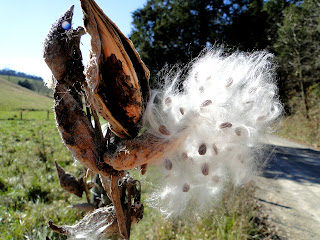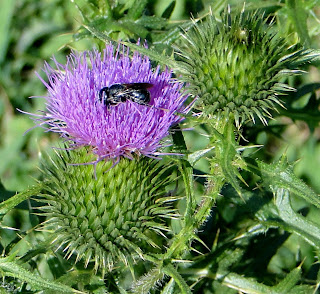 Honey Bee on Wingstem
Honey Bee on Wingstem (Actinomeris alternifolia)
My honey bees are foraging nectar and pollen for the past several weeks on Wingstem, a native plant in the composite family. The plant is easy to identify by the stems which have "wings" actually leaves on each side of the stem (seen in the upper right of the photo).
 Wingstem in Pasture
Wingstem in PastureThe tall (4 feet or more) plants cover most of the pastures around here. Cows don't eat the plants so I am glad the farmers don't brush-hog the plants to get rid of this important source of nectar. Both bumble and honey bees collect orange pollen from the Wingstem. Fritillary butterflies were also on the flowers. I admit I never thought these plants were pretty but now I have an appreciation for this plant now that my bees seem to love it!
When I went back to the hive, I noticed that bees were collecting several different colors of pollen-orange, light yellow, and bright yellow. Perhaps they are foraging on the goldenrod but I haven't seen it (not much goldenrod compared to wingstem here).
 Lion's Foot
Lion's Foot (
Prenanthes serpentaria)
This lovely native wildflower, Lion's Foot, came up around my hive this summer. I did see a honey bee on it so maybe that's where they are getting the white pollen. I was surprised this flower was in the composite family (daises, dandelions, sunflowers). The leaves do look similar to dandelion leaves though.
My Bee Hive UpdateMy hive inspection of September 4 showed that the bees were very strong in 2 of the medium boxes (box 2 and 3 of 4)--good brood pattern surrounded by pollen and nectar. Bees were all over the 8 frames. On the bottom of the hive, box 1was almost empty of brood--and only a little pollen and not that many bees. Box 4 on the top had more bees and 3 frames of honey.
As I have done all summer (usually 10 day intervals), I used the powdered sugar treatment for varroa mites. This time, I kept the mite check board underneath just to see what I was getting. The next day, I counted about 150 mites on the board! Also worrisome was that I counted 3 wax moth caterpillars--these guys can ruin honeycomb quickly.
Last week, I attended the meeting of the local bee club (New River Valley Beekeepers Association). There I told the group about what I found. Jerry, club president, reassured me about the mites--the powdered sugar treatment gets rid of 80% of the mites so I probably don't have too much of a mite problem.
Mark, an expert beekeeper, recommended the following:
1. Reverse boxes, putting box 1 where box 3 is to have the bees clean it out. Later, if it's empty, remove it for the winter. That will put more bees on the bottom where they can guard against the wax moths and other intruders.
2. Keep box 4 on--hopefully the bees will fill it out and keep it for their winter supply (darn--would have liked that honey!).
3. Start feeding with 1:1 syrup to prompt bees to build up the brood--should have 3 medium boxes of brood/honey/pollen for winter.

I did not have another medium box to use for the jar I put on the top for the syrup. With my husband's help, I made a box out of old shelves--it works fine on top.
During my last inspection (Sept. 11), I noticed there were no wax moths so I was relieved. I reversed the boxes as recommended and noticed more bees at the entrance already. I again did the powdered sugar treatment. I checked for mites on Saturday--only a couple found on the mite check board!
Throw the Bums Out!
One beekeeper mentioned that the workers (female) were throwing the drones (male) out of the hive. The drones don't do any work except mate with virgin queens. Their job done for the season, the workers will discard them so they don't have to waste resources this winter.

This worker appeared to be biting the large drone. When the drones try to return, the workers will not allow them in, repeating the harassment.

This worker rode on the back of the drone, both falling right out of the hive. The worker returned while the drone flew away.
These workers don't show any mercy. When I have accidentally squashed a bee during inspection, bees come over to get any pollen or nectar. So, I should not be surprised at this behavior--everything is for the hive, no slackers allowed!


















































